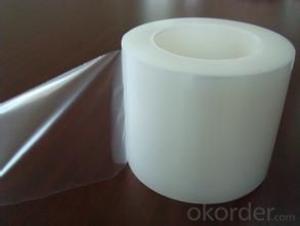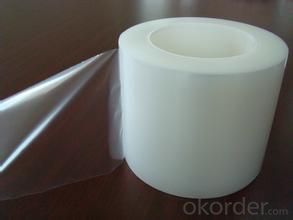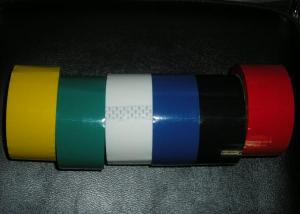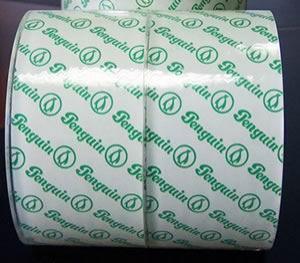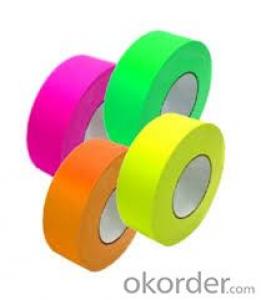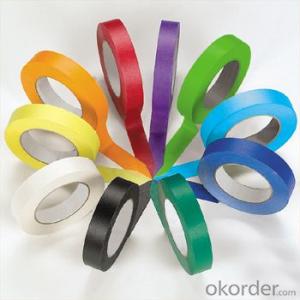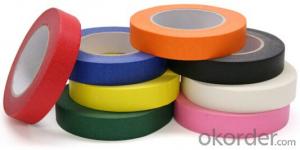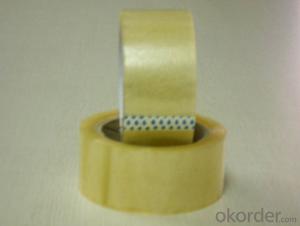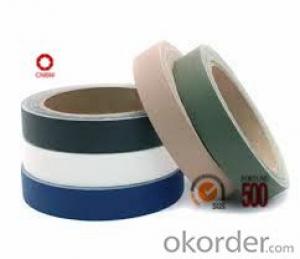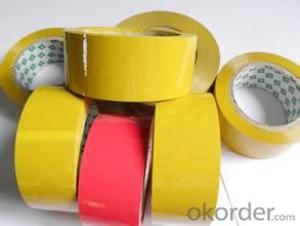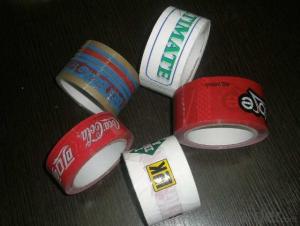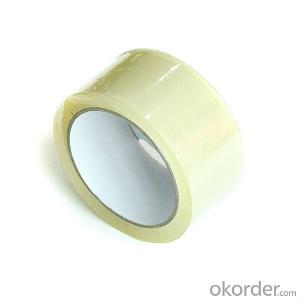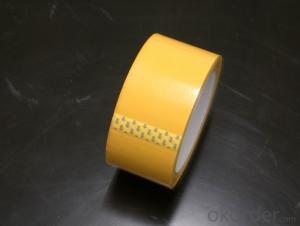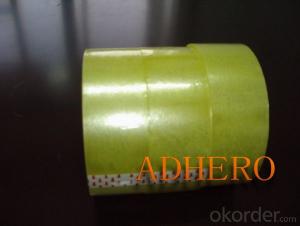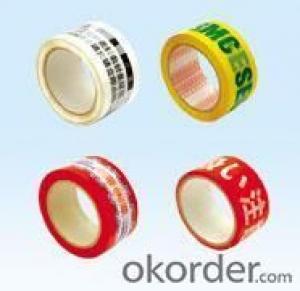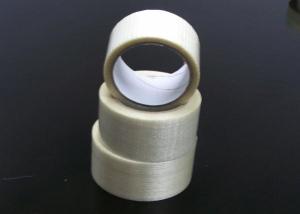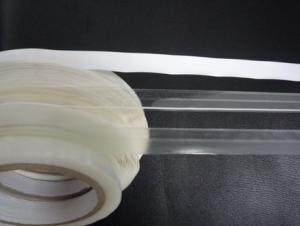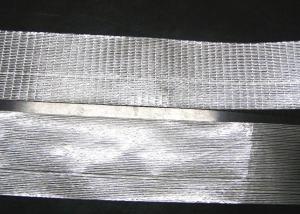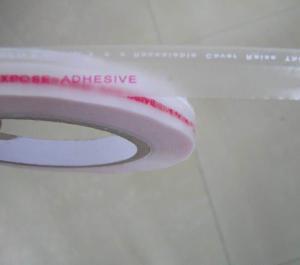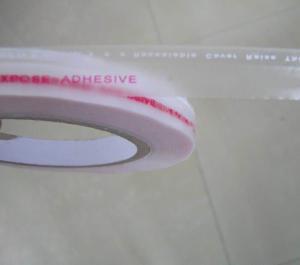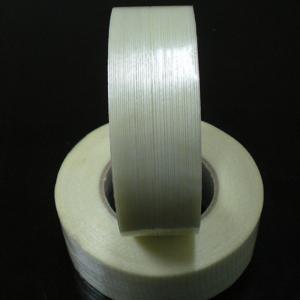Tesa Clear Packaging Tape with OPP Packing Tapes and Customer Designs Printed Logo
- Loading Port:
- Fuzhou
- Payment Terms:
- TT OR LC
- Min Order Qty:
- 500 m²
- Supply Capability:
- 50000 m²/month
OKorder Service Pledge
OKorder Financial Service
You Might Also Like
Introduction of OPP Packing Tape
OPP packing tape are made of BOPP films coated with acrylic adhesive.
Application of OPP Packing Tape
1. Industrial box parking
2. outside electronics product packing with safety material
3. gift wrapping &decoration
4. general purpose repair
5. bundling &strapping
6. stationery purpose
Advantage of OPP Packing Tape
1.Packing tape, superb tack and adhesion to surface, Strong grip that is ensured because of an excellent adhesive backing.
2. Peak performance even under extreme conditions of pressure and temperature, which can stick to all types of surfaces.
3. Consistent quality
4. on time delivery
5. Effective and timely communication
6. Competitive price
Packing of OPP Packing Tape
individually wrapped, shrink, carton.
6rolls/shrink, about 36~100rolls/carton(according to different specifications)
carton size : any carton size as your request
Pictures of OPP Packing Tape
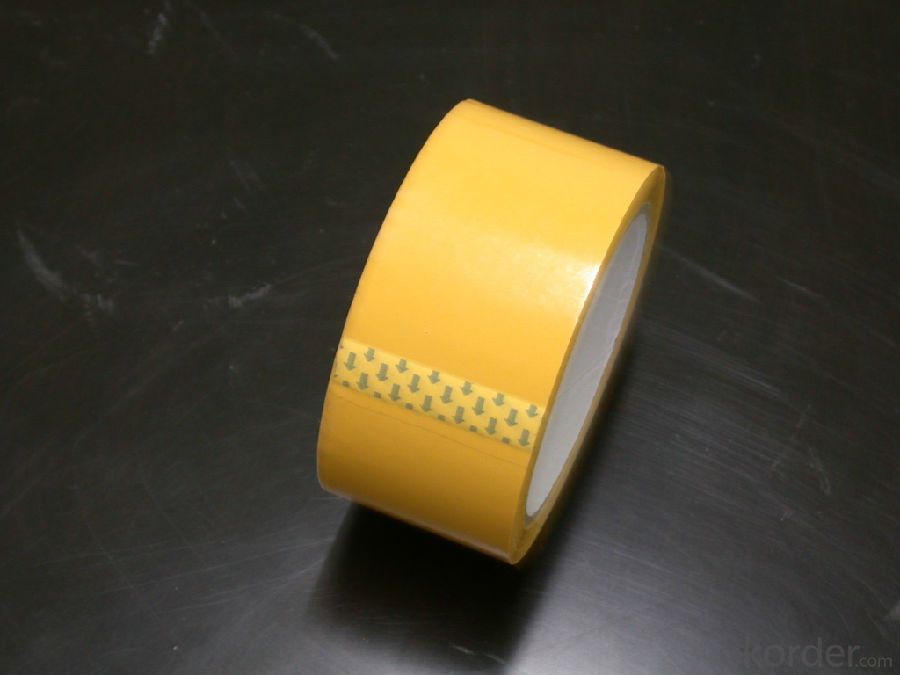
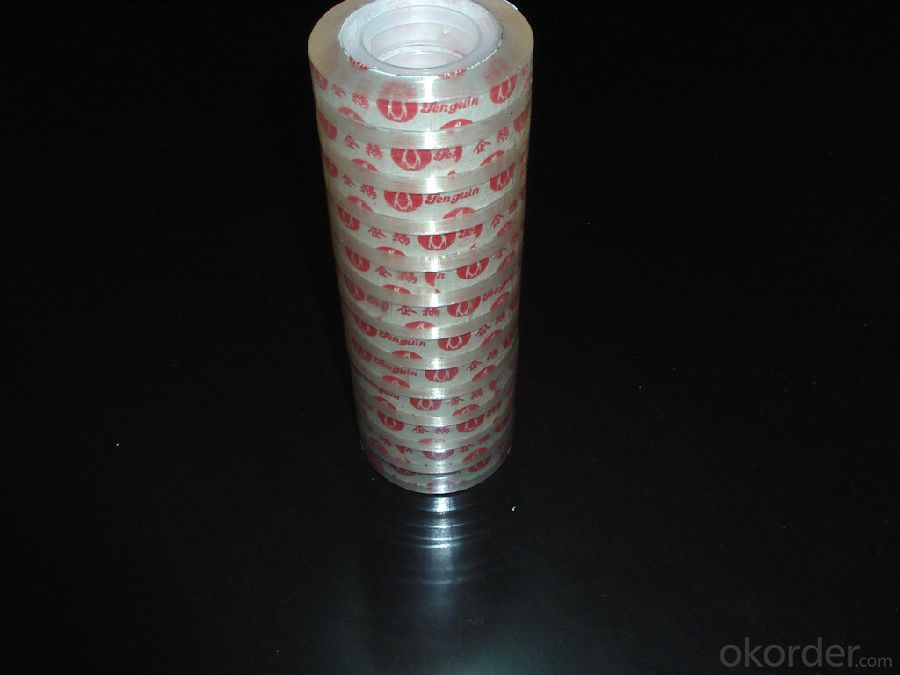
Specification of OPP Packing Tape
| Material | OPP |
| Adhesive Side | Single Sided. |
| Adhesive | Acrylic, Water based acrylic adhesive |
| Acrylic | Water based acrylic adhesive |
| Color | Transparent clear/yellowish /tan brown/blue/red/ green |
| Normal thickness | 36mic, 38mic, 40mic, 43mic, 45mic, 46mic, 48mic,50mic, 52mic |
| Packaging | Single packed, shrink film packed, depend on customer’s request |
Remarks:
1. The data above are typical results and subject to change without notice.
2. Tolerance: Weight and Thickness: ±10%; Width: ±3mm;
Length: Cut Roll & Log Roll ±0.3m, Jumbo Roll ±0.5%.
3. The products should be stored at room temperature and kept from wet and heat source.
4. It is essential, as with all pressure-sensitive tapes, that the surface to which the tape is applied must be clean, dry, and free of grease and oil.
5. The user should take test and do trial-application on the above products before coming into application so as to witness and ensure suitability for user’s special purpose and technique.
FAQ
1. What is the range of your products?
So far, we manufacture various kinds of double sided adhesive tape, masking tape, kraft tape and BOPP packing tape. To better meet your needs, we can also source other adhesive tapes for you if it is appropriate to do so.
2. What's the lead time for delivery?
We ensure you a prompt delivery of the goods. We do not stock any of the goods. The production cycle time of 1*20FCL is 2-3 weeks.
3. How many carriers does your double sided adhesive tapes have?
There are many carriers that our double sided adhesive tapes based on, which are tissue, PET, BOPP, PE foam, EVA foam.
4.Can you accept the cooperation way of OEM?
Upon receipt of formal authorization, we can accept OEM processing.
5.What are the international commodity codes for these products?
HS Code: 48231900.
6.Are you offering only jumbos rolls or slit rolls as well?
We offer Jumbos, logs, and slit rolls. All different sizes are available.
- Q: Is packaging tape safe to use on plastic picture frames?
- Yes, packaging tape is generally safe to use on plastic picture frames. It provides a secure and temporary hold without causing damage to the frame's surface. However, it is important to remove the tape carefully to avoid peeling off any paint or finish.
- Q: Can packaging tape be used for bundling items together?
- Yes, packaging tape can be used for bundling items together.
- Q: Can packaging tape be used for sealing plastic wrap?
- Yes, packaging tape can be used for sealing plastic wrap. It provides a strong adhesive bond that helps secure the plastic wrap in place, keeping the contents protected and sealed.
- Q: Does packaging tape come in different widths for sealing different-sized items?
- Packaging tape is available in various widths to seal items of different sizes, offering flexibility and customization in packaging and sealing. When packaging an item, the choice of tape width depends on its size and weight. For smaller or lighter items, narrower tapes like 1-inch or 2-inch can be used effectively. Conversely, wider tapes such as 3-inch or 4-inch are more suitable for larger or heavier packages, ensuring secure sealing. The availability of different tape widths guarantees optimal protection during storage and transportation of items with varying sizes.
- Q: Can packaging tape be used for sealing packages with delicate fabrics or clothing?
- Yes, packaging tape can be used for sealing packages with delicate fabrics or clothing. However, it is important to exercise caution and take certain precautions to protect the delicate items. Here are a few tips to ensure safe packaging: 1. Use a wide, clear packaging tape: Opt for a wide tape that allows for a larger surface area of adhesion. Clear tape is preferable as it reduces the risk of leaving any visible residue or marks on the fabric. 2. Double-layer the tape: Apply two layers of packaging tape to provide extra strength and security to the package. This will help prevent the tape from accidentally peeling off during transit. 3. Wrap the delicate items securely: Before sealing the package, make sure to wrap the delicate fabrics or clothing in a protective layer, such as tissue paper or bubble wrap. This additional layer will act as a buffer and safeguard the items from any potential damage caused by the tape. 4. Avoid excessive tension: While sealing the package, be careful not to pull too tightly on the tape. Applying excessive tension may cause the fabric to stretch or distort, potentially damaging the delicate item. 5. Consider alternative options: If the delicate item is particularly fragile or valuable, it may be worth considering alternative packaging materials, such as acid-free tissue paper or garment bags. These options provide even more protection and are specifically designed for preserving delicate fabrics and clothing. Ultimately, while packaging tape can be used for sealing packages with delicate fabrics or clothing, it is essential to handle the items with care and take appropriate measures to minimize any potential damage during the packaging process.
- Q: How does packaging tape perform in high-temperature conditions?
- Packaging tape typically functions well in high-temperature settings, but its effectiveness can differ depending on the specific type and quality of the tape. Most packaging tapes are engineered to endure a range of temperatures and are generally resistant to heat up to a certain degree. However, it is important to note that extreme temperatures, particularly those surpassing the tape's specified heat resistance limit, can impact its adhesive properties and overall performance. When exposed to high temperatures, the adhesive on packaging tape may soften or weaken, leading to reduced bonding strength and potential tape failure. This can result in packages opening or becoming less secure during transportation or storage. Additionally, heat can cause the tape to lose flexibility, making it more susceptible to cracking or breaking. Thus, it is vital to choose packaging tape specifically designed for high-temperature environments if there is anticipated exposure to extreme heat. Certain types of packaging tape, such as fiberglass-reinforced or high-temperature resistant tapes, are better suited for enduring high temperatures. These tapes are often manufactured with special adhesives and materials that provide enhanced heat resistance and improved performance in extreme conditions. They are designed to maintain their adhesive strength, bonding capability, and structural integrity even when confronted with elevated temperatures. In conclusion, although packaging tape can generally endure high-temperature conditions, its performance may be compromised when subjected to extreme heat. Utilizing tapes specifically designed for high-temperature environments can help ensure optimal performance and securely seal packages even in challenging conditions.
- Q: What are the considerations for using packaging tape on plastic packaging materials?
- When using packaging tape on plastic packaging materials, there are several important considerations to keep in mind. These considerations include: 1. Adhesive Compatibility: It is crucial to ensure that the adhesive used in the packaging tape is compatible with the specific type of plastic material being used. Different plastics have different surface properties and may require different adhesive formulations to ensure proper bonding. For example, low surface energy plastics like polyethylene may require a tape with a specific adhesive designed to adhere to such surfaces. 2. Strength and Durability: Plastic packaging materials come in various thicknesses and strengths. When selecting packaging tape, it is important to consider the strength and durability required for the specific plastic material being used. The tape should be strong enough to securely hold the packaging together without tearing or breaking, ensuring the integrity of the package during handling and transportation. 3. Temperature Resistance: Plastic packaging materials can be sensitive to temperature changes. If the package is exposed to extreme temperatures such as heat or cold, the packaging tape should be able to withstand these conditions without losing its adhesive properties. Certain plastic materials may also shrink or expand due to temperature changes, which can affect the adhesion of the tape. Therefore, it is important to choose a tape that is suitable for the expected temperature range. 4. Residue and Damage: Some packaging tapes may leave behind adhesive residue or cause damage when removed from plastic packaging materials. This can be problematic if the packaging needs to be reused or if the plastic material is sensitive to damage. Selecting a packaging tape that is designed to be easily removable or leaves minimal residue can help mitigate these concerns. 5. Regulatory Compliance: Depending on the industry or product being packaged, there may be specific regulations and standards that need to be followed. It is important to ensure that the packaging tape used complies with any applicable regulations, such as food safety standards or environmental requirements. By considering these factors, one can select the appropriate packaging tape that will effectively adhere to plastic packaging materials while also providing the necessary strength, durability, temperature resistance, and compliance with regulations.
- Q: How do I prevent packaging tape from losing its adhesive properties?
- To prevent packaging tape from losing its adhesive properties, it is important to store it in a cool, dry place away from direct sunlight and extreme temperatures. Additionally, ensure that the surface where the tape is applied is clean and free from any dust, oil, or moisture, as these can compromise the adhesive. Applying the tape firmly and evenly, avoiding excessive stretching, can also help maintain its adhesive strength.
- Q: Is packaging tape easy to remove without damaging surfaces?
- Packaging tape is generally designed to be easily removable without causing damage to surfaces. However, the ease of removal can vary depending on several factors such as the type and quality of the tape, the surface it is applied to, and the length of time it has been in place. Most packaging tapes are designed to adhere firmly to surfaces during transit or storage, ensuring that the package remains sealed and secure. However, they are also designed to be peeled off easily when needed, without leaving behind residue or causing damage. In most cases, packaging tape can be removed by simply peeling it off slowly and evenly. The adhesive used in packaging tapes is typically formulated to have a good balance between adhesion and removability. This allows for easy removal without requiring excessive force or leaving behind sticky residue. However, there can be instances where the tape may be more difficult to remove, especially if it has been in place for an extended period or exposed to extreme temperature conditions. In such cases, it may be helpful to use heat (such as a hairdryer) to soften the adhesive, making it easier to peel off. It is worth noting that the ease of tape removal can also depend on the surface it is applied to. Smooth, non-porous surfaces like glass or metal are generally easier to clean without any damage. On the other hand, porous or delicate surfaces like wood or painted walls may require more caution and care during removal to avoid any potential damage. In conclusion, while packaging tape is generally easy to remove without damaging surfaces, it is important to consider factors such as tape quality, surface type, and removal technique to ensure a smooth and damage-free removal process.
- Q: How do I prevent packaging tape from tearing during application?
- To prevent tearing of packaging tape during application, there are several measures that can be taken: 1. Opt for the appropriate type of packaging tape: It is essential to select a high-quality packaging tape that is specifically designed for heavy-duty applications. Look for tapes that are explicitly labeled as tear-resistant or reinforced. 2. Prepare the surface adequately: Before applying the tape, ensure that the surface is thoroughly cleaned, dried, and devoid of any dust or debris. A dirty or uneven surface can easily cause the tape to tear. 3. Employ the correct technique: When applying the tape, hold the roll at a slight angle in relation to the surface rather than perpendicular. Applying it at an angle will minimize friction between the tape and the surface, thus reducing the likelihood of tearing. 4. Apply gentle pressure: Apply the tape smoothly and evenly, exerting gentle pressure. Avoid pulling or tugging excessively, as it can strain the tape and increase the risk of tearing. 5. Steer clear of extreme temperatures: Extreme temperatures can have an impact on the adhesive properties of the tape, rendering it more susceptible to tearing. If possible, store the tape in a controlled environment and refrain from using it in excessively hot or cold conditions. 6. Consider utilizing a tape dispenser: Employing a tape dispenser can facilitate smoother and more even application of the tape, thereby minimizing the chances of tearing. It also offers improved control and reduces strain on the tape. 7. Cut the tape precisely: When cutting the tape, employ a sharp blade or scissors to ensure a clean cut. A jagged or uneven cut can weaken the tape and make tearing more likely. By adhering to these suggestions, the likelihood of packaging tape tearing during application can be significantly reduced, guaranteeing a secure and dependable seal for your packages.
Send your message to us
Tesa Clear Packaging Tape with OPP Packing Tapes and Customer Designs Printed Logo
- Loading Port:
- Fuzhou
- Payment Terms:
- TT OR LC
- Min Order Qty:
- 500 m²
- Supply Capability:
- 50000 m²/month
OKorder Service Pledge
OKorder Financial Service
Similar products
Hot products
Hot Searches
Related keywords
